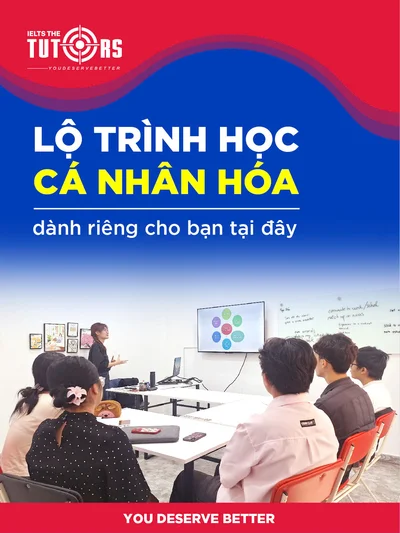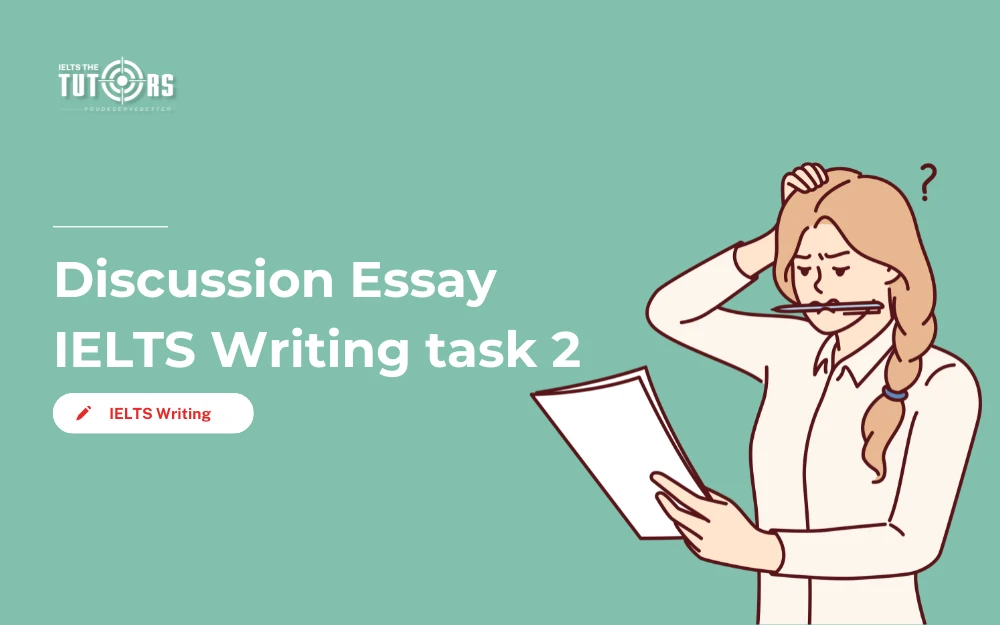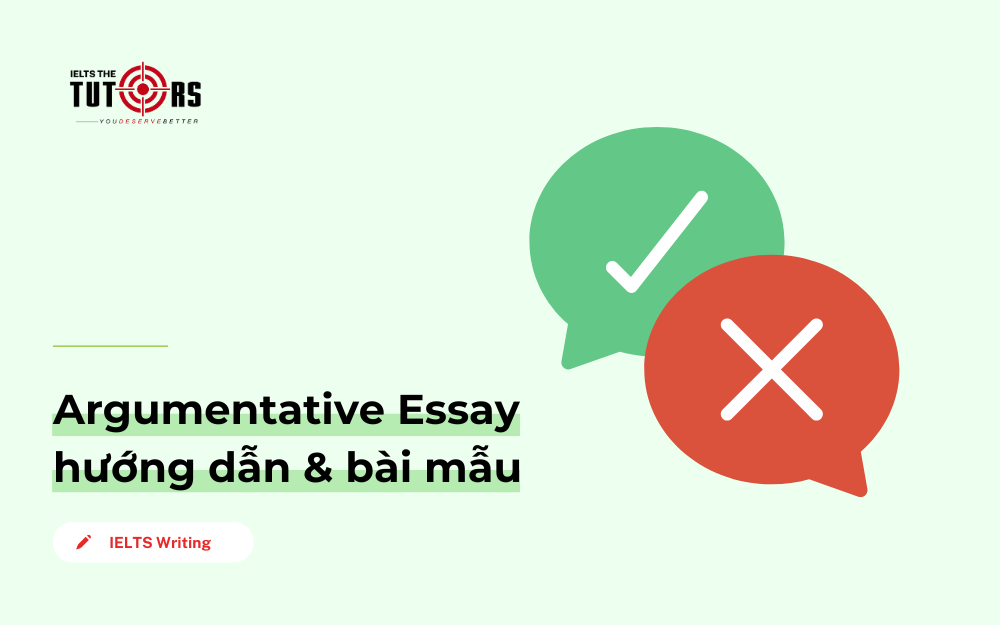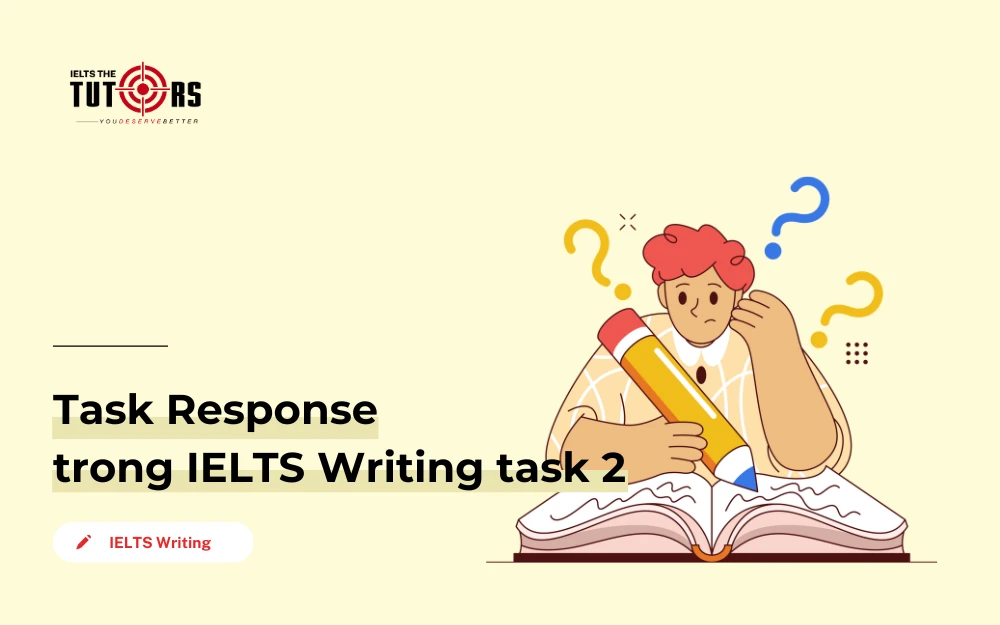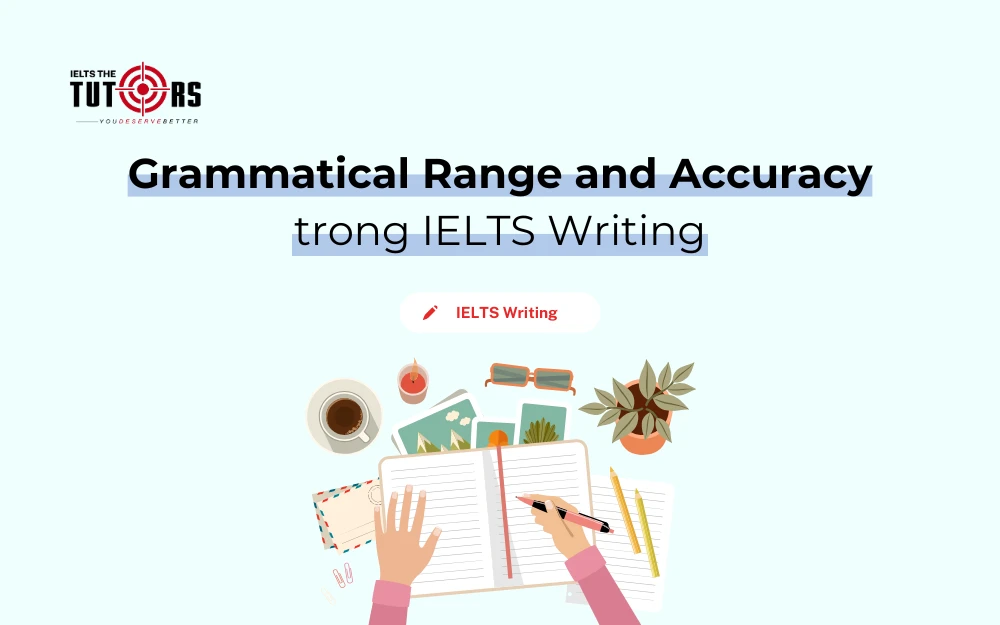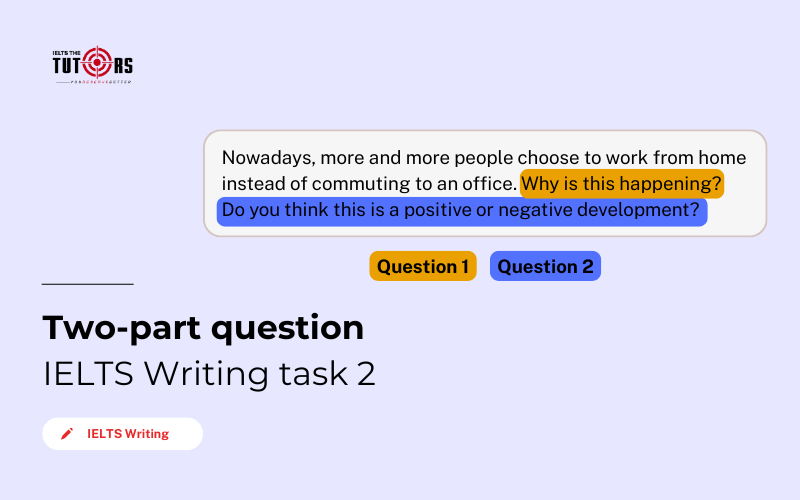
Trong bài thi IELTS Writing Task 2, thí sinh cần viết một bài luận để trả lời câu hỏi được đưa ra trong đề bài. Tùy vào yêu cầu, các đề bài sẽ thuộc nhiều dạng khác nhau, chẳng hạn như Problem and Solution, Opinion, Discussion, v.v.
Trong bài viết này, chúng ta sẽ tập trung vào dạng Two-part Question, một dạng đề phổ biến trong IELTS Writing Task 2. Bạn sẽ được hướng dẫn cách nhận diện dạng bài, xây dựng bố cục bài viết hiệu quả và áp dụng chiến lược viết rõ ràng, thuyết phục kèm theo bài mẫu chi tiết.
Two-part question trong IELTS Writing task 2 là gì?
Two-part Question (còn gọi là Direct Question hoặc Double Question) là một trong những dạng đề phổ biến trong IELTS Writing Task 2. Đề bài sẽ đưa ra hai câu hỏi riêng biệt, yêu cầu thí sinh trả lời cả hai trong bài luận.
Tương tự như các dạng bài khác, IELTS Writing task 2 chiếm tới 60% điểm số của bài thi Writing. Vì vậy, hãy luyện tập thật kỹ để đạt điểm cao trong phần thi này.
Dưới đây là ví dụ cụ thể về dạng bài Two-part question:
Đề bài 1: Nowadays, more and more people choose to work from home instead of commuting to an office. Why is this happening? Do you think this is a positive or negative development?
Trong ví dụ này, bạn phải trả lời 2 câu hỏi bao gồm:
- Câu 1: Why is this happening? – Tại sao ngày càng có nhiều người chọn làm việc tại nhà thay vì đến văn phòng?
- Câu 2: Do you think this is a positive or negative development? – Bạn có nghĩ rằng đây là một sự phát triển tích cực hay tiêu cực?

Đề bài 2: In some countries, university students choose to live with their parents while studying, whereas in others, they prefer to live independently. What are the reasons for these differences? Which do you think is a better option?
Trong ví dụ này, bạn phải trả lời 2 câu hỏi bao gồm:
- Câu 1: What are the reasons for these differences? – Những lý do nào giải thích sự khác biệt này?
- Câu 2: Which do you think is a better option? – Theo bạn, lựa chọn nào tốt hơn?
Các câu hỏi trong Two-part question khá cụ thể và rõ ràng, vì vậy thí sinh sẽ hạn chế bị lạc đề hơn khi trả lời.
*Lưu ý: Không được bỏ sót bất kỳ câu hỏi nào! Nếu chỉ trả lời một câu hỏi, bạn sẽ bị trừ điểm nặng ở tiêu chí Task Response.
Tham khảo: Tổng hợp từ vựng IELTS Writing task 2 theo chủ đề phổ biến
Cách viết Two-part question IELTS Writing task 2 hiệu quả
Bạn có thể hoàn thiện bài Two-part question bằng 3 bước đơn giản dưới đây:
- Bước 1: Phân tích đề bài và xác định quan điểm
- Bước 2: Lập dàn ý và phát triển ý tưởng
- Bước 3: Kiểm tra lại bài làm và chỉnh sửa lỗi chính tả
Cùng áp dụng các bước làm bài này vào ví dụ cụ thể dưới đây nhé:
Đề bài mẫu (Nguồn: Cambridge IELTS 16, Test 2):
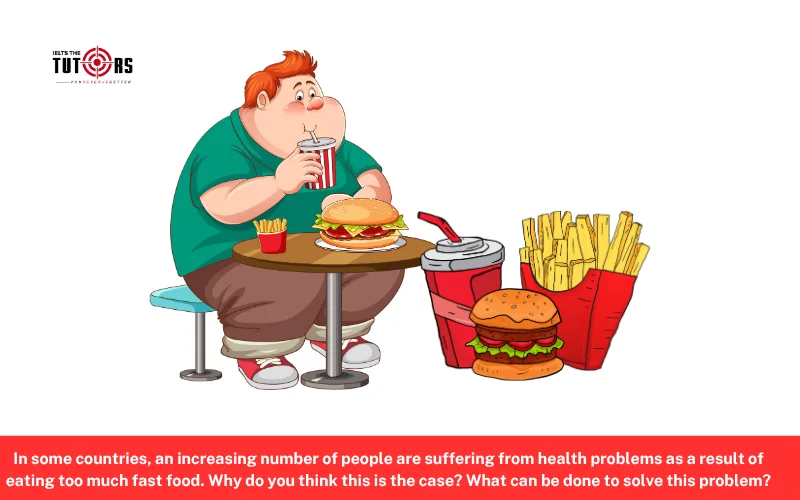
“In some countries, an increasing number of people are suffering from health problems as a result of eating too much fast food. Why do you think this is the case? What can be done to solve this problem?”
Bước 1: Phân tích đề bài và xác định quan điểm
Trong IELTS Writing Task 2, đề bài có thể được trình bày theo nhiều dạng khác nhau, vì vậy, việc đọc kỹ và phân tích đề là bước quan trọng để đảm bảo bài viết đáp ứng đúng tiêu chí Task Achievement và tránh bị lạc đề. Trước khi bắt đầu viết, hãy dành ít nhất 3 phút để xác định chủ đề chính cũng như yêu cầu cụ thể của đề bài, từ đó xây dựng luận điểm một cách rõ ràng và logic.
Phân tích đề bài trên, ta có:
- Chủ đề: Vấn đề sức khỏe do tiêu thụ quá nhiều thức ăn nhanh.
- Câu hỏi 1: Nguyên nhân dẫn đến tình trạng này?
- Câu hỏi 2: Giải pháp cho vấn đề này?
Trong dạng bài nghị luận xã hội của IELTS Writing Task 2, việc thể hiện quan điểm cá nhân một cách rõ ràng là yếu tố quan trọng. Để tạo ấn tượng với giám khảo ngay từ đầu, bạn nên trình bày quan điểm của mình ngay trong Introduction và đảm bảo lập luận nhất quán xuyên suốt bài viết. Đến phần Conclusion, hãy nhắc lại quan điểm này một lần nữa để củng cố lập luận và tạo sự kết nối chặt chẽ cho bài viết.
Bước 2: Lập dàn ý và phát triển ý tưởng
| Introduction |
|
| Body | Body 1: Nguyên nhân của vấn đề
Body 2: Giải pháp
|
| Conclusion | Tóm tắt lại vấn đề và nhấn mạnh tầm quan trọng của sự phối hợp giữa chính phủ, doanh nghiệp và cá nhân để giải quyết tình trạng này. |
Bước 3: Kiểm tra lại bài làm và chỉnh sửa lỗi chính tả
Sau khi hoàn thành bài làm, hãy dành chút thời gian cuối giờ để rà soát kỹ lưỡng. Kiểm tra lỗi ngữ pháp, đảm bảo bài viết đáp ứng đúng yêu cầu đề bài và nằm trong giới hạn từ quy định. Một bước kiểm tra cẩn thận có thể giúp bạn tránh những sai sót đáng tiếc và nâng cao chất lượng bài viết.
Sample ví dụ trên:
Introduction
In recent years, the consumption of fast food has become increasingly common, leading to a rise in health problems such as obesity and heart disease in many countries. This issue stems from several factors, including the convenience of fast food, aggressive marketing strategies, and a lack of awareness about nutrition. However, there are practical solutions that can be implemented by governments, businesses, and individuals to mitigate the negative effects of excessive fast-food consumption.
Body Paragraph 1: Causes of the problem
One major reason why fast food consumption is on the rise is its convenience, especially for people with hectic lifestyles. With long working hours and busy schedules, many individuals prefer quick and easy meal options rather than preparing home-cooked food. As a result, they often rely on fast food, which is readily available and requires minimal effort.
Additionally, marketing strategies used by fast-food chains significantly contribute to this trend. Large corporations invest heavily in advertisements that target consumers, particularly young people. Eye-catching promotions, meal deals, and discounts make fast food an attractive option for many. Moreover, fast-food restaurants are strategically located in high-traffic areas, making them easily accessible.
Lastly, a lack of awareness about nutrition exacerbates the issue. Many people, particularly in lower-income groups, are unaware of the long-term health consequences of consuming excessive amounts of fast food. Since these meals are often cheaper than healthier alternatives, they become the primary choice for those on a tight budget. Unfortunately, regular consumption of such food leads to serious health complications, including diabetes and cardiovascular diseases.
Body Paragraph 2: Solutions to the problem
To tackle this issue, governments should play a crucial role by implementing higher taxes on fast food, similar to taxation on cigarettes and alcohol. This would discourage excessive consumption and encourage people to seek healthier options. Furthermore, educational programs on nutrition should be introduced in schools to raise awareness about the importance of a balanced diet from an early age.
In addition, fast-food companies should take responsibility by offering healthier menu options. Providing transparent nutritional information on packaging and menus can help consumers make informed choices. Some global brands have already started incorporating salads and low-calorie meals into their menus, which is a step in the right direction.
At the individual level, raising awareness and adopting healthier eating habits is essential. People should make a conscious effort to limit their intake of fast food and incorporate home-cooked meals into their daily routine. Parents, in particular, can encourage their children to develop healthier eating habits by setting a positive example.
Conclusion
In conclusion, the rising consumption of fast food and its associated health problems are primarily due to convenience, aggressive marketing tactics, and a lack of nutritional awareness. However, by imposing stricter regulations, promoting education on healthy eating, and encouraging individuals to make better dietary choices, this issue can be effectively addressed. A collaborative effort from governments, businesses, and individuals is necessary to ensure a healthier future for society.
Vocabulary:
- Consumption (n) /kənˈsʌmpʃən/: Sự tiêu thụ
- Hectic lifestyle (n) /ˈhɛktɪk ˈlaɪfˌstaɪl/: Lối sống bận rộn
- Home-cooked meal (n) /hoʊm kʊkt miːl/: Bữa ăn tự nấu tại nhà
- Readily available (adj) /ˈrɛdəli əˈveɪləbəl/: Có sẵn một cách dễ dàng
- Aggressive marketing strategy (n) /əˈɡrɛsɪv ˈmɑrkɪtɪŋ ˈstrætədʒi/: Chiến lược tiếp thị mạnh mẽ
- Eye-catching promotion (n) /aɪ ˈkætʃɪŋ prəˈmoʊʃən/: Chương trình khuyến mãi bắt mắt
- Lack of nutritional awareness (n) /læk əv nuˈtrɪʃənəl əˈwɛrnəs/: Thiếu nhận thức về dinh dưỡng
- Excessive consumption (n) /ɪkˈsɛsɪv kənˈsʌmpʃən/: Việc tiêu thụ quá mức
- Processed food (n) /ˈprɑː.sɛst fuːd/: Thực phẩm chế biến sẵn
- Implement higher tax (v) /ˈɪmplɪmɛnt ˈhaɪər tæks/: Áp dụng mức thuế cao hơn
- Educational program on nutrition (n) /ˌɛdʒʊˈkeɪʃənəl ˈproʊɡræm ɒn nuˈtrɪʃən/: Chương trình giáo dục về dinh dưỡng
- Promote healthier dietary choice (v) /prəˈmoʊt ˈhɛlθiər ˈdaɪətəri ʧɔɪs/: Khuyến khích lựa chọn chế độ ăn uống lành mạnh
- Transparent nutritional information (n) /trænsˈpɛrənt nuˈtrɪʃənəl ˌɪnfərˈmeɪʃən/: Thông tin dinh dưỡng minh bạch
- Incorporate healthier menu option (v) /ɪnˈkɔːrpəreɪt ˈhɛlθiər ˈmɛnjuː ˈɒpʃən/: Bổ sung các lựa chọn thực đơn lành mạnh
- Regulation on advertising (n) /ˌrɛɡjəˈleɪʃən ɒn ˈædvərˌtaɪzɪŋ/: Quy định về quảng cáo
Một số cấu trúc ngữ pháp ghi điểm trong Two-part question
Để đạt điểm cao trong bài IELTS Writing Task 2 dạng Two-part question không chỉ cần một chiến lược trả lời hiệu quả và dàn ý logic mà còn phải sử dụng linh hoạt các cấu trúc ngữ pháp và cụm từ phức tạp. Những yếu tố này không chỉ giúp bài viết của bạn mạch lạc hơn mà còn tạo ấn tượng tốt với giám khảo.
Dưới đây là một số cấu trúc câu hữu ích mà bạn có thể áp dụng để làm bài viết trở nên chuyên nghiệp và tự nhiên hơn.
Tham khảo đầy đủ: Các cấu trúc câu ăn điểm trong Writing task 2 bạn cần biết
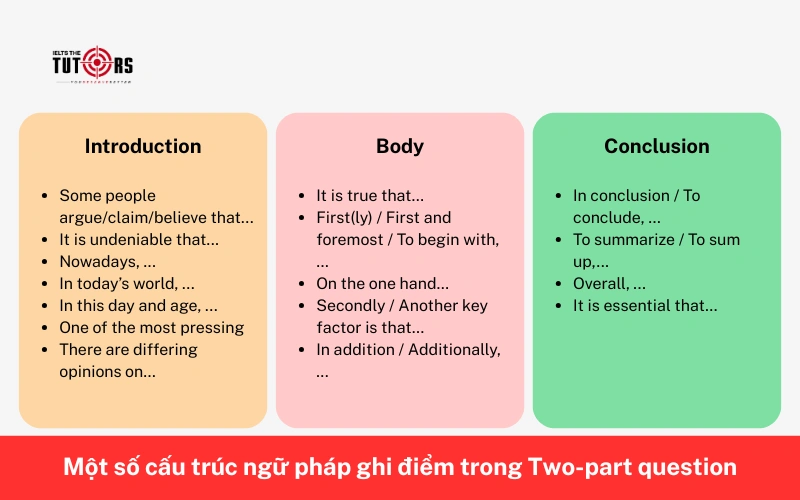
Mở bài (Introduction)
Một phần mở bài hấp dẫn cần giới thiệu vấn đề một cách rõ ràng và tự nhiên. Bạn có thể sử dụng các cấu trúc sau:
- Some people argue/claim/believe that…
- It is undeniable that…
- Nowadays, … / In today’s world, … / In this day and age, …
- One of the most pressing / controversial / significant issues today is…
- There are differing opinions on…
Ví dụ: It is undeniable that fast food consumption has surged dramatically in recent years, raising concerns about its long-term impact on public health.
Triển khai ý (Body)
Body 1:
Phần này giới thiệu nguyên nhân hoặc mặt lợi/hại của vấn đề. Một số cách triển khai hiệu quả:
- It is true that…
- First(ly) / First and foremost / To begin with, …
- Many people hold the view that…
- One primary reason for this is…
- On the one hand…
Ví dụ: One primary reason for the increasing health issues related to fast food consumption is its affordability and accessibility. Many people, especially those with busy lifestyles, opt for convenience over nutrition.
Body 2:
Đoạn này có thể phân tích hậu quả hoặc giải pháp cho vấn đề. Bạn có thể sử dụng các mẫu câu như:
- Secondly / Another key factor is that…
- In addition / Additionally, …
- What’s more, …
- On the other hand…
- A potential solution to this issue is…
Ví dụ: Another key factor is the aggressive marketing strategies of fast food companies, which influence consumer choices, particularly among younger generations.
Đưa ra ví dụ (Giving examples)
Một bài viết thuyết phục cần có ví dụ cụ thể. Một số cách diễn đạt bạn có thể dùng:
- For example / For instance,…
- Take (something) as an example, …
- A prime example of this is…
- To illustrate / To demonstrate,…
Ví dụ: A prime example of this is the widespread presence of fast food chains in urban areas, where consumers are constantly exposed to advertisements promoting unhealthy eating habits.
Kết bài (Conclusion)
Phần kết cần tóm tắt lại quan điểm một cách rõ ràng và mạnh mẽ. Một số cách diễn đạt hữu ích:
- In conclusion / To conclude, …
- To summarize / To sum up,…
- Overall, …
- It is essential that…
Ví dụ: In conclusion, while fast food offers convenience, its negative effects on health cannot be ignored. Governments and individuals must take proactive steps to promote healthier dietary choices and regulate the marketing of unhealthy food products.
Bài mẫu IELTS Writing Two-part question
Đề bài: Many companies sponsor sports as a way of advertising themselves. Some people think this is good for the world of sport, while others think it is a bad idea. What are the advantages and disadvantages of allowing companies to sponsor sports events?
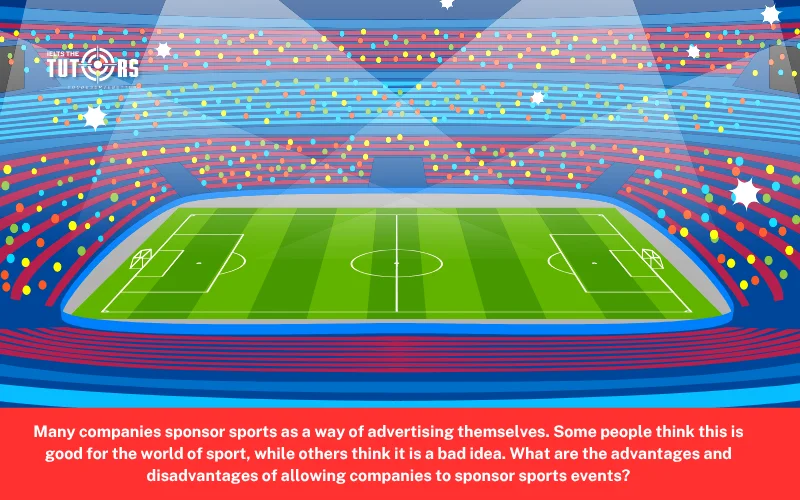
Corporate sponsorship in sports has become a common marketing strategy, with major companies investing substantial funds in sporting events. While this financial support offers numerous benefits to the sports industry, it also raises concerns about commercialization and ethical implications. This essay will explore both the advantages and disadvantages of corporate sponsorship in sports.
One of the primary benefits of corporate sponsorship is the financial stability it provides to sports organizations. Many professional and amateur sports events rely heavily on sponsorship deals to cover operational costs, player salaries, and infrastructure development. Without corporate backing, some sports might struggle to survive.
Moreover, sponsorship allows athletes and teams to focus solely on performance rather than financial constraints. For instance, large sponsorship deals enable teams to invest in high-quality training facilities, equipment, and medical support, ultimately raising the standard of competition.
Additionally, corporate sponsorship can enhance the popularity of sports. When globally recognized brands associate themselves with sporting events, they attract a broader audience, increasing viewership and fan engagement. This, in turn, contributes to the overall growth of the industry.
Despite these benefits, corporate sponsorship in sports also presents several drawbacks. One significant concern is the excessive commercialization of sports. When companies prioritize profit over the essence of sportsmanship, events may become more about branding and advertising rather than fair competition.
Another issue is the potential conflict between brand image and sports values. For example, fast food and alcohol companies often sponsor major tournaments, sending mixed messages about health and fitness. This could negatively influence young audiences, promoting unhealthy lifestyles rather than athletic discipline.
Furthermore, sponsorship deals can create financial disparities between teams and athletes. Wealthier clubs and athletes who secure lucrative deals have an advantage over underfunded competitors, leading to an uneven playing field. This economic gap may reduce the spirit of fair competition, as success becomes more dependent on financial backing than talent.
In conclusion, corporate sponsorship provides crucial financial support, improves sports facilities, and broadens audience reach. However, it also brings challenges, such as commercialization, ethical concerns, and financial inequality. To maximize the benefits while minimizing the drawbacks, regulatory bodies should ensure sponsorship aligns with the core values of sports, promoting fairness and integrity.
Vocabulary:
- Corporate sponsorship (n) /ˈkɔːrpərət ˈspɒnsərʃɪp/: Tài trợ doanh nghiệp
- Financial stability (n) /faɪˈnænʃəl stəˈbɪləti/: Sự ổn định tài chính
- Commercialization (n) /kəˌmɜːrʃələˈzeɪʃən/: Sự thương mại hóa
- Ethical implication (n) /ˈɛθɪkəl ˌɪmplɪˈkeɪʃən/: Hệ quả đạo đức
- Unfair advantage (n) /ʌnˈfɛər ədˈvæntɪdʒ/: Lợi thế không công bằng
- Regulatory body (n) /ˌrɛɡjəˈleɪtəri ˈbɒdi/: Cơ quan quản lý
- Transparent sponsorship policy (n) /trænsˈpɛrənt ˈspɒnsərʃɪp ˈpɒlɪsi/: Chính sách tài trợ minh bạch
- double-edged sword (phrase) /ə ˌdʌbəl ˈɛdʒd sɔːrd/: Con dao hai lưỡi
- Striking a balance between… (phrase) /ˈstraɪkɪŋ ə ˈbæləns bɪˈtwiːn/: Đạt được sự cân bằng giữa…
- Ensuring a level playing field (phrase) /ɪnˈʃʊrɪŋ ə ˈlɛvəl ˈpleɪɪŋ fiːld/: Đảm bảo một sân chơi công bằng
Two-part Question trong IELTS Writing task 2 không phải là dạng bài quá khó nếu như bạn có chiến thuật làm bài đúng và hiệu quả, áp dụng các bước làm bài ở trên kết hợp với mở rộng vốn từ vựng học thuật sẽ giúp bạn vượt quá Writing task 2 dễ dàng hơn với điểm số tối ưu. Nếu muốn nâng cao band điểm của mình nhanh chóng, hãy tham khảo ngay các khóa học IELTS tại IELTS The Tutors để được tư vấn miễn phí nhé!

